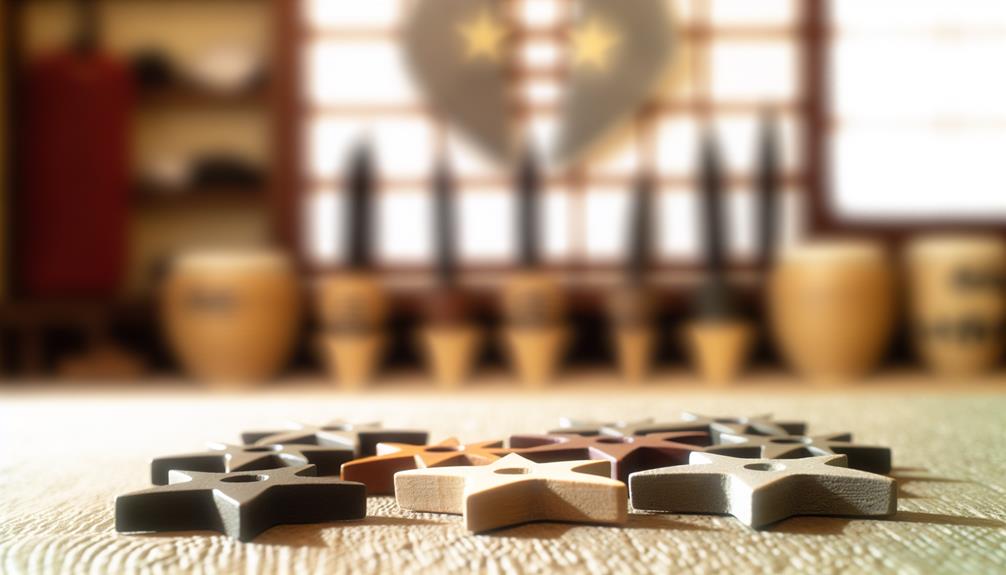
Brainstorm Security Shop

For Orders Over $199

On Any Of Our Products

Details On Refund Page
You’ve likely seen throwing stars in movies, depicted as silent but deadly weapons wielded by shadowy figures. However, there’s more to these intriguing tools than just cinematic flair. In the realm of tactical training, they offer a unique blend of physical skill, mental focus, and strategic application. Mastering the art of throwing stars requires precision, control, and an understanding of dynamics that can enhance your overall tactical abilities. Whether you’re a professional seeking to expand your skill set or a hobbyist interested in the mechanics of projectile weapons, exploring the potential of throwing stars in modern training scenarios opens up a new dimension in precision weaponry. What might surprise you is how their usage could shift your approach to tactical situations.
Throwing stars, also known as shuriken, have a fascinating origin rooted in feudal Japan. Initially, they weren’t just weapons but tools that represented the ingenuity and resourcefulness of the ninjas who used them.
You mightn’t realize it, but these stars carried tremendous cultural significance. They symbolized the stealth and the strategic minds of their wielders, often used not for outright combat but for distraction and misdirection.
Among the legendary users, certain names stand out. Figures like Hattori Hanzo, a name you’ve perhaps heard in tales or seen glorified in films, actually used these tools.
These ninjas weren’t mere shadows; they were strategic masters of their environment, using shuriken to control the flow of battle and to escape tight situations.
Imagine holding a piece of that history in your hand—the weight of the star, the points balanced perfectly for throwing. It’s a connection to a past where skill and precision meant survival.
These tools weren’t just thrown; they were guided by careful hands, steeped in a tradition of martial prowess and tactical acumen. The shuriken wasn’t just a silent weapon; it was a silent testament to a ninja’s skill.
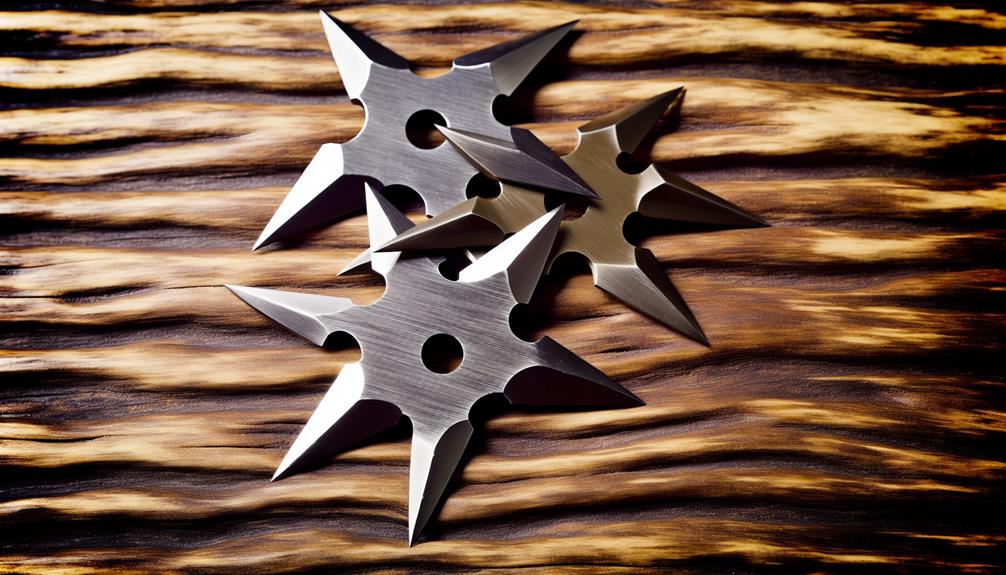
As you explore the types of throwing stars, you’ll find that they vary widely in materials, from traditional metals to modern composites.
Each design has unique features that affect performance and technique. Understanding these variations can significantly enhance your tactical training effectiveness.
Over the years, tactical enthusiasts and martial artists have employed a variety of materials to craft throwing stars. The choice between steel versus aluminum hasn’t only influenced performance but also carried historical significance.
Originally, steel was predominantly used due to its durability and substantial weight, which aided in stable, accurate throws. Its ability to maintain a sharp edge also made steel throwing stars highly effective in their traditional role in Japanese weaponry.
On the other hand, aluminum, being lighter and resistant to corrosion, offers you an alternative that’s easier to handle, especially for beginners. Its lightweight nature allows for quicker throws, though it may sacrifice some impact force compared to steel.
You’ll find that aluminum stars can be less intimidating, making them a popular choice in modern tactical training scenarios.
When you’re selecting a throwing star, remember that the material affects not just the star’s functionality but also how you train with it.
Steel stars are excellent for practicing precision and control, while aluminum stars can enhance your speed and agility. Understanding these differences helps you choose the right star that best suits your training needs and goals.
Shifting focus to design variations, throwing stars come in numerous shapes and sizes, each tailored for specific tactical purposes. You’ll find that the design aesthetics aren’t just for show; they serve distinct functional roles. For instance, some stars feature sharp, angular points ideal for sticking into targets, while others boast more rounded edges designed to inflict surface-level impact.
Exploring further, the ergonomic shapes of these stars ensure that they fit comfortably in your hand, facilitating a secure grip and precise release. This aspect is crucial because a well-designed grip can significantly enhance your control and accuracy during a throw.
Among the most popular designs are the four-pointed stars, which provide a balanced throw from almost any angle. However, if you’re looking for something with a bit more bite, eight-pointed stars offer multiple penetrating points, increasing your chances of hitting your mark.
Design variations also extend to weight distribution. Some stars are heavier towards the center, promoting a more stable, predictable flight path. Others distribute weight towards the tips, allowing for quicker spins and a faster strike.
Each star’s design is a careful balance of aesthetics, ergonomics, and functionality, designed to meet the diverse needs of tactical training enthusiasts like yourself.
To effectively use throwing stars, you’ll need to master several techniques tailored to the type of star you choose. Each star has its unique design, influencing the ideal throwing angles and grip techniques you should adopt. Let’s delve into these aspects.
First, consider the grip. For a basic four-point star, the pinch grip works best. You’ll hold a single point between your thumb and forefinger, ensuring a firm yet flexible hold. This grip allows for quick, fluid throws and is adaptable to most star designs.
As you progress, experiment with different grips like the overhand or the side pinch to see what enhances your precision and control.
Throwing angles are just as crucial. A straight throw might seem intuitive, but adjusting the angle slightly can drastically improve the star’s trajectory and sticking power. For instance, if you’re using a heavier, six-point star, a slight upward tilt helps maintain a stable, aerodynamic flight.
Practice these techniques consistently. Begin with shorter distances, focusing on your grip and release. As you get more comfortable, increase the distance, adjusting your throwing angles to maintain accuracy.
When you’re selecting the right throwing star, the material and durability are crucial factors to consider.
You’ll also need to weigh your options on size and weight to match your handling preferences.
Choosing wisely will enhance your performance and ensure your training is effective.
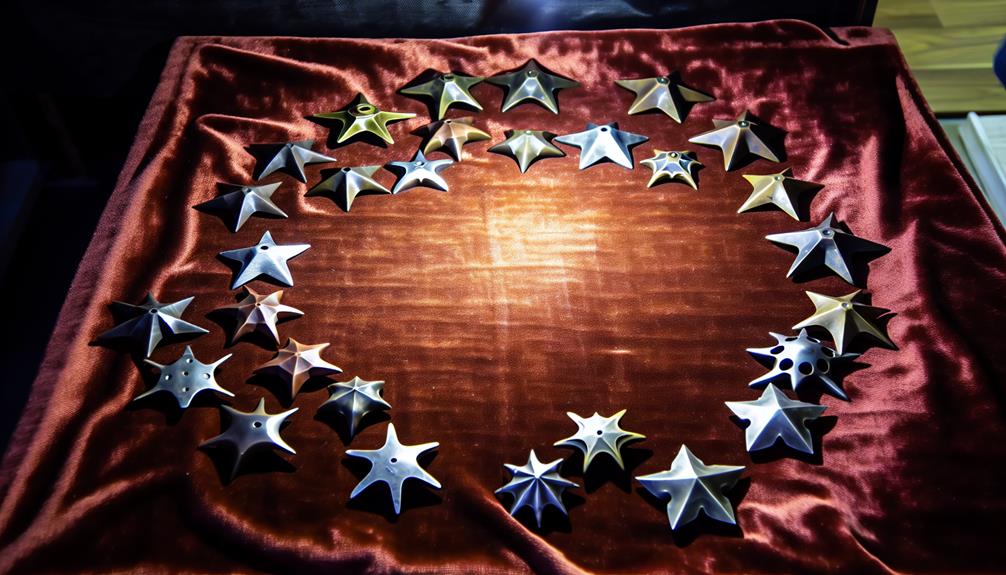
In choosing the right throwing star for tactical training, the material and durability are paramount. You’ll want to select a star that not only meets tactical training benefits but also appeals to your sense of throwing star aesthetics.
Stainless steel is a popular choice, renowned for its resistance to rust and corrosion. It maintains a gleaming appearance even with minimal maintenance, ensuring that your star always looks sharp in both senses of the word.
However, don’t overlook other materials like carbon steel, which can offer superior toughness. Carbon steel stars are exceptionally durable, capable of withstanding rigorous use.
They do require more care to prevent rust, but this small effort can significantly extend their lifespan. This makes them a practical option if you’re serious about your training.
Several factors come into play when selecting the ideal size and weight of a throwing star for tactical training.
First, you’ve got to consider size comparisons among different models. Larger stars may seem more intimidating, but they’re often slower due to their increased air resistance. Smaller stars, on the other hand, can be quicker and more discreet, yet they require greater skill to handle precisely.
Weight distribution is another crucial aspect. A well-balanced star ensures that it rotates consistently through the air, improving your accuracy.
Think of it this way: if the weight is unevenly distributed, the star might wobble or veer off course. That’s the last thing you want during a precision-based training session.
As you begin to learn the fundamentals of throwing technique, it’s crucial to adopt a balanced stance. Your feet should be shoulder-width apart, with one foot slightly ahead of the other to maintain stability. This position ensures you’re ready to execute a precise throw without losing balance.
Mastering grip techniques is equally important. Hold the throwing star between your thumb and forefinger, securing it at one of its points. The grip shouldn’t be too tight; you need enough flexibility to release the star smoothly during your throw.
Now, let’s delve into throwing mechanics. Start by focusing your gaze on your target. Bring the throwing star up beside your head, keeping your elbow bent.
As you move into the throw, rotate your torso from the hips to generate power, extending your arm towards the target in a fluid motion. Release the star when your hand points directly at the target, ensuring a straight, energy-efficient trajectory.
Safety is paramount when practicing with throwing stars. You’ll need to conduct a thorough risk assessment before you begin. Identify potential hazards like inadequate space, bystanders, and improper targets. Ensuring your practice environment is clear of unnecessary risks is a foundational step in injury prevention.
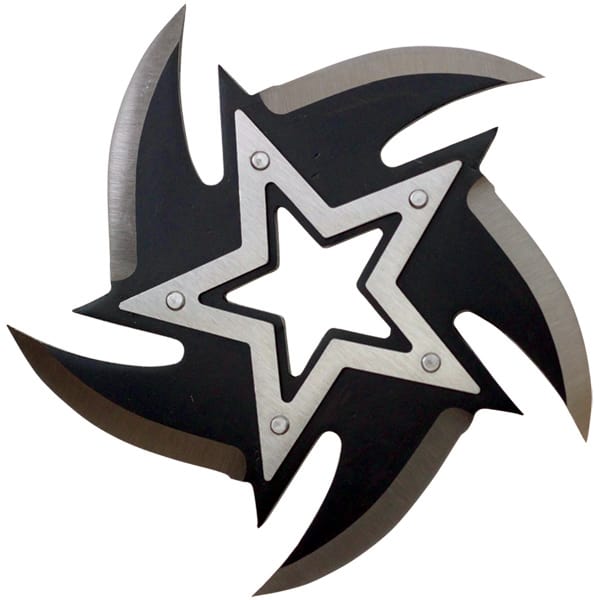
Always wear appropriate protective gear. This includes eye protection, gloves, and possibly body armor designed to protect you from accidental injuries. Don’t skimp on quality here; proper gear is your first defense against mishaps.
It’s crucial you’re trained on how to handle and throw stars correctly. Mishandling these tools can lead to serious injuries, so consider professional instruction to refine your technique and safety practices.
Regularly inspect your throwing stars for damage such as chips or blunted edges, which can alter their flight and increase the risk of accidents.
Lastly, always have a first aid kit accessible. Despite all precautions, accidents can happen, and you’ll want to be prepared to handle cuts or other injuries immediately.
Now that you’re familiar with the safety measures, let’s start with some basic training exercises designed for beginners.
First up, you’ll need to get comfortable with the grip. Hold your throwing star between your thumb and forefinger. Make sure it’s snug but not too tight—you don’t want to restrict its release.
Next, let’s move onto some simple throwing drills. Find a safe, designated target area. Stand about five feet away to begin with. You’re aiming to build muscle memory, so consistency is key. Practice throwing with a smooth, controlled motion. Focus on your form rather than force. The goal here is precision, not power.
Here are a few beginner tips to keep in mind: always keep your wrist straight to avoid any unnecessary strain. Your elbow should lead the motion, with your arm following in a natural, fluid movement.
Repeat this process, gradually increasing the distance as you become more comfortable and accurate.
Once you’ve mastered the basics, it’s time to explore advanced throwing techniques that can significantly enhance your precision and speed. At this level, you’re aiming to improve both your throwing accuracy and tactical precision. These skills are vital for hitting your targets reliably under various conditions.
Let’s delve into the “No-Spin Throw,” which is crucial for maintaining the star’s path straight towards the target, minimizing rotation to improve accuracy. Here’s how you align your grip and posture:
| Step | Description |
|---|---|
| 1 | Align your thumb along the flat edge of the star. |
| 2 | Position the star between your thumb and forefinger. |
| 3 | Keep your elbow tight to your body to control the throw. |
| 4 | Aim directly at your target, focusing on a specific point. |
| 5 | Release the star with a smooth, straight motion without wrist flick. |
Practice this technique until it feels natural, and you’ll notice a significant improvement in your control and throwing accuracy. Remember, the key to mastering these advanced skills lies in consistent practice and a keen focus on each movement’s precision. Don’t rush the process; take your time to develop these advanced skills thoroughly.
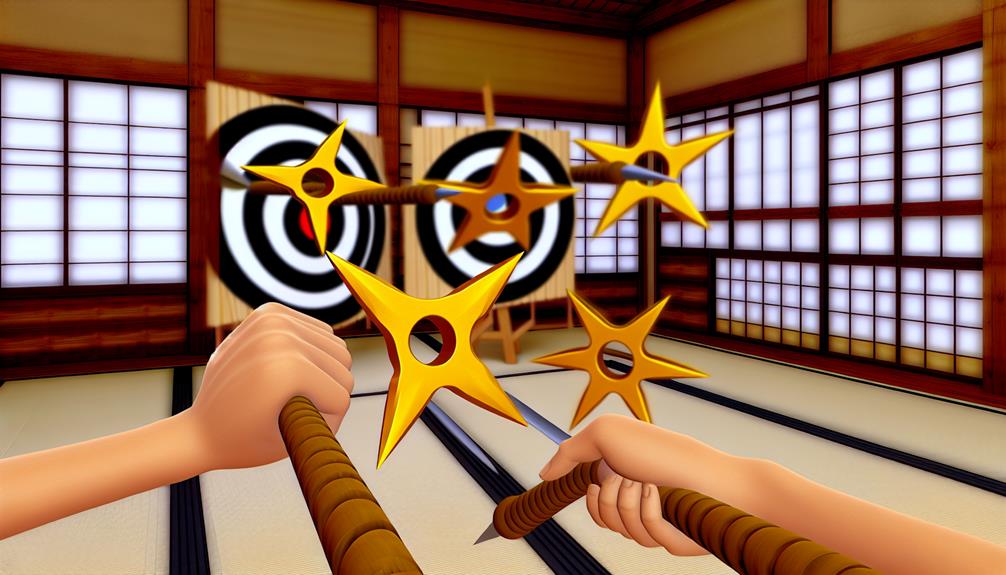
Mastering advanced throwing techniques like the No-Spin Throw offers you a significant edge in tactical situations where precision and speed are paramount.
In the realm of modern warfare, particularly in urban environments, the integration of traditional skills like throwing stars can provide surprising tactical advantages.
Here’s how these ancient tools fit into modern combat scenarios:
Incorporating throwing stars into your fitness routine can elevate both your physical and tactical skills. Fitness integration using throwing stars, or star workouts, isn’t just about throwing; it involves a holistic approach to boost your agility, precision, and strength. You’ll find that these exercises not only refine your throwing technique but also enhance your overall fitness.
Here’s a simple table to get you started on a week-long plan:
| Day | Exercise | Benefit |
|---|---|---|
| Mon | Target throws | Improves accuracy & precision |
| Tue | Sprint and throw | Boosts cardio & coordination |
| Wed | Weighted star holds | Enhances grip & arm strength |
| Thu | Repetitive star draws | Increases speed & muscle memory |
| Fri | Cool down stretches | Aids recovery & flexibility |
Each session should begin with a warm-up and end with cool-down stretches to prevent injuries. Remember, the key to fitness integration with star workouts is consistency. You aren’t just training your body; you’re sharpening your mind. As you progress, you can increase the complexity and intensity of the workouts. Keep challenging yourself, and you’ll see significant improvements in both your tactical abilities and physical health.
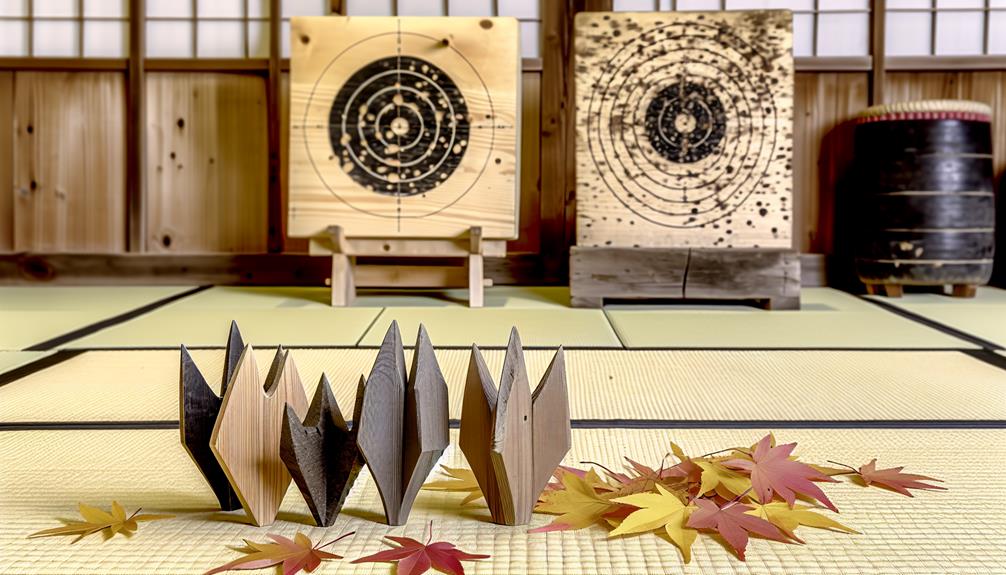
Taking good care of your throwing stars ensures they remain effective and safe to use.
You’ll need to master proper cleaning techniques to avoid rust and damage.
Additionally, finding secure storage solutions helps maintain their condition and keeps them out of the wrong hands.
After each use, cleaning your throwing stars is crucial to maintain their effectiveness and prolong their life. Dirt, debris, and even fingerprints can affect their flight and precision, not to mention the potential for rust and corrosion if they’re left unattended.
Here are some maintenance tips and the right cleaning tools to keep them in top shape.
These simple steps will keep your throwing stars clean, sharp, and ready for your next training session.
Once your throwing stars are clean and dry, it’s time to focus on how you store them to ensure their longevity and safety.
You’ll want to choose storage containers designed specifically for sharp objects. Opt for containers with robust locking mechanisms to prevent unauthorized access. Material types are crucial; metal or hard plastic offers durability and added security measures.
Consider the climate control within your storage area. A controlled environment prevents rust and corrosion—factors that can degrade your throwing stars over time.
Portable solutions are also worth looking into, especially if you’re often on the move. These should have secure closures and customizable compartments.
Implementing organizational systems within your containers can greatly enhance space optimization and inventory management. Adjustable dividers allow you to tailor the space according to size and quantity, making it easier to find what you need quickly.
Accessibility features, such as labels and clear lids, help in identifying contents at a glance without compromising security.
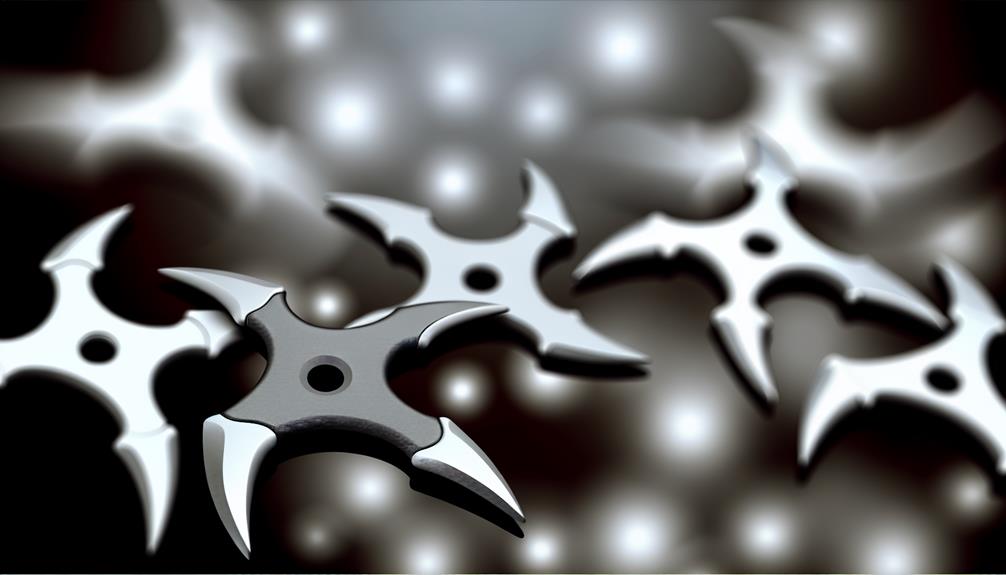
You might wonder if throwing stars can fit into competitive sports. Indeed, they can be used in events focused on competitive throwing and skill development.
These competitions test precision, control, and technique, similar to archery or javelin. Participants must adhere to strict safety protocols, ensuring the environment is secure for both competitors and spectators.
It’s a niche sport that highlights not only physical skill but also mental focus and discipline.
If you’re considering training with throwing stars, you should know that age restrictions often apply.
Many places set specific age requirements to ensure safety, particularly when it involves youth training.
It’s crucial to check local regulations or with the training facility to confirm if there are minimum age limits.
This is to ensure that young participants are mature enough to handle the responsibilities and risks associated with this type of training.
If you’re considering the legal implications of owning throwing stars, it’s crucial to check local laws first.
Legal ownership can vary widely, with some areas treating them as prohibited weapons, while others may allow them with restrictions.
Additionally, using them for self-defense carries further legal risks and consequences.
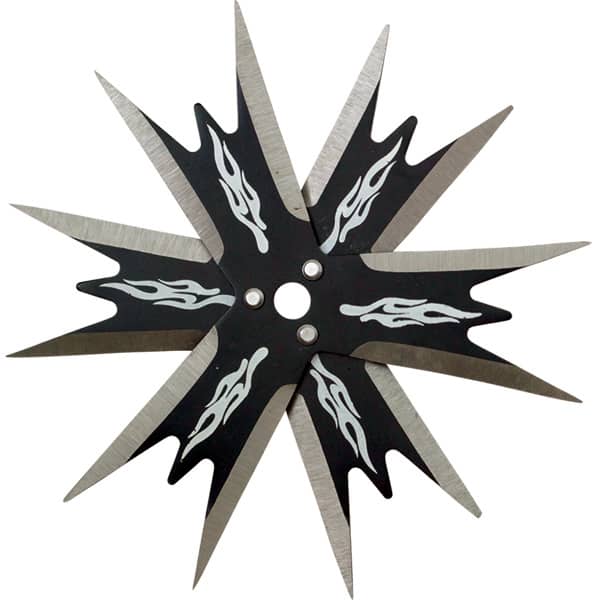
Make sure you’re fully informed about both ownership and usage laws in your area to avoid any legal troubles.
Weather conditions significantly impact your throwing star performance. High humidity can affect the metal, potentially altering its weight and flight path, while strong winds might resist its trajectory, making accurate throws more challenging.
You’ll find that both humidity impact and wind resistance play crucial roles in your ability to hit the target consistently. Adjusting your technique to accommodate these changes can help maintain precision and effectiveness in varying environmental conditions.
Absolutely, you can have personalized or custom-made items to suit your preferences.
Various design options and material choices allow you to tailor them specifically to your needs, whether you’re looking for something unique in appearance or requiring specific performance characteristics.
You’ll find that customizing these items not only enhances their functionality but also gives them a personal touch that reflects your style and requirements perfectly.
As you explore the diverse world of throwing stars, remember to choose the right type for your skills and goals. Master the fundamentals and progressively challenge yourself with advanced techniques. Always prioritize safety and maintain your equipment diligently. Whether you’re incorporating throwing stars into your tactical training or fitness routine, they offer a unique blend of precision, discipline, and physical activity. Keep practicing, and you’ll enhance not only your throwing skills but also your strategic thinking and overall agility.
